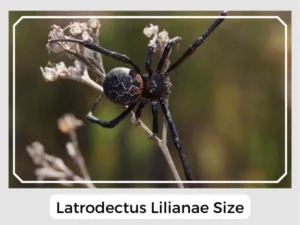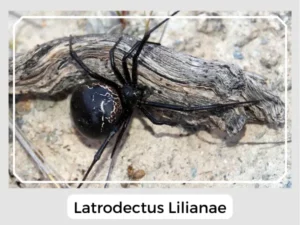The Latrodectus lilianae spider is part of the comb-footed spider family. It’s found in a place called the Iberian peninsula. These spiders are interesting, and we’re excited to share some cool facts about them with you in this article!

Photo Credit: Jose Carrillo
Females produce egg sacs laid inside the nests between May and July.
They disperse during summer, building small webs among the grass and weeds.
It consists of an inverted cone-shaped nest made of permanent, non-adhesive silk threads. Built-in low shrubbery, 20-40 cm above the ground, the threads hang downwards, attached to the soil or nearby vegetation. The spider suspends highly adhesive hunting threads, spun at sunset, and removed at sunrise.
Yes, Latrodectus lilianae spiders have venom. The full extent is unknown but they can be as dangerous as other true black widows.
They can bite if they’re bothered. The bite might feel like a tiny pinch and may cause several symptoms, but most people don’t find it too worrisome.

Photo Credit: Jose Carrillo
The Latrodectus lilianae plays a vital role in maintaining the ecological balance within its habitat, preying on a variety of insects such as beetles and woodlice. Its nocturnal hunting rituals, coupled with its unique web architecture, showcase the spider’s adaptation to its dry and arid steppe environments.
Natural Predators: Bird species like the hoopoe, along with wasps and small mammals, are known predators of the Latrodectus lilianae, creating a dynamic balance within the food chain.
Prey-Predator Dynamics: The intricate dance between Latrodectus lilianae and its predators is a testament to the delicate balance of nature, ensuring that no single species dominates the ecosystem.
Relationship with Humans: While encounters with humans are infrequent due to the spider’s reclusive nature, it’s crucial for individuals to exercise caution and respect their space, minimizing potential risks.
| Lifespan | 1-3 years |
| Distribution | Portugal and Spain |
| Habitat | Dry or arid steppes |
| Common Predators | Birds like the hoopoe, wasps, and small mammals |
| Diet | Insects like beetles and woodlice |
In summary, the Latrodectus lilianae spider stands as a beacon of fascination and mystery within the arachnid world.
The Latrodectus lilianae spider is part of the comb-footed spider family. It’s found in a place called the Iberian peninsula. These spiders are interesting, and we’re excited to share some cool facts about them with you in this article!

Photo Credit: Jose Carrillo
Females produce egg sacs laid inside the nests between May and July.
They disperse during summer, building small webs among the grass and weeds.
It consists of an inverted cone-shaped nest made of permanent, non-adhesive silk threads. Built-in low shrubbery, 20-40 cm above the ground, the threads hang downwards, attached to the soil or nearby vegetation. The spider suspends highly adhesive hunting threads, spun at sunset, and removed at sunrise.
Yes, Latrodectus lilianae spiders have venom. The full extent is unknown but they can be as dangerous as other true black widows.
They can bite if they’re bothered. The bite might feel like a tiny pinch and may cause several symptoms, but most people don’t find it too worrisome.

Photo Credit: Jose Carrillo
The Latrodectus lilianae plays a vital role in maintaining the ecological balance within its habitat, preying on a variety of insects such as beetles and woodlice. Its nocturnal hunting rituals, coupled with its unique web architecture, showcase the spider’s adaptation to its dry and arid steppe environments.
Natural Predators: Bird species like the hoopoe, along with wasps and small mammals, are known predators of the Latrodectus lilianae, creating a dynamic balance within the food chain.
Prey-Predator Dynamics: The intricate dance between Latrodectus lilianae and its predators is a testament to the delicate balance of nature, ensuring that no single species dominates the ecosystem.
Relationship with Humans: While encounters with humans are infrequent due to the spider’s reclusive nature, it’s crucial for individuals to exercise caution and respect their space, minimizing potential risks.
| Lifespan | 1-3 years |
| Distribution | Portugal and Spain |
| Habitat | Dry or arid steppes |
| Common Predators | Birds like the hoopoe, wasps, and small mammals |
| Diet | Insects like beetles and woodlice |
In summary, the Latrodectus lilianae spider stands as a beacon of fascination and mystery within the arachnid world.